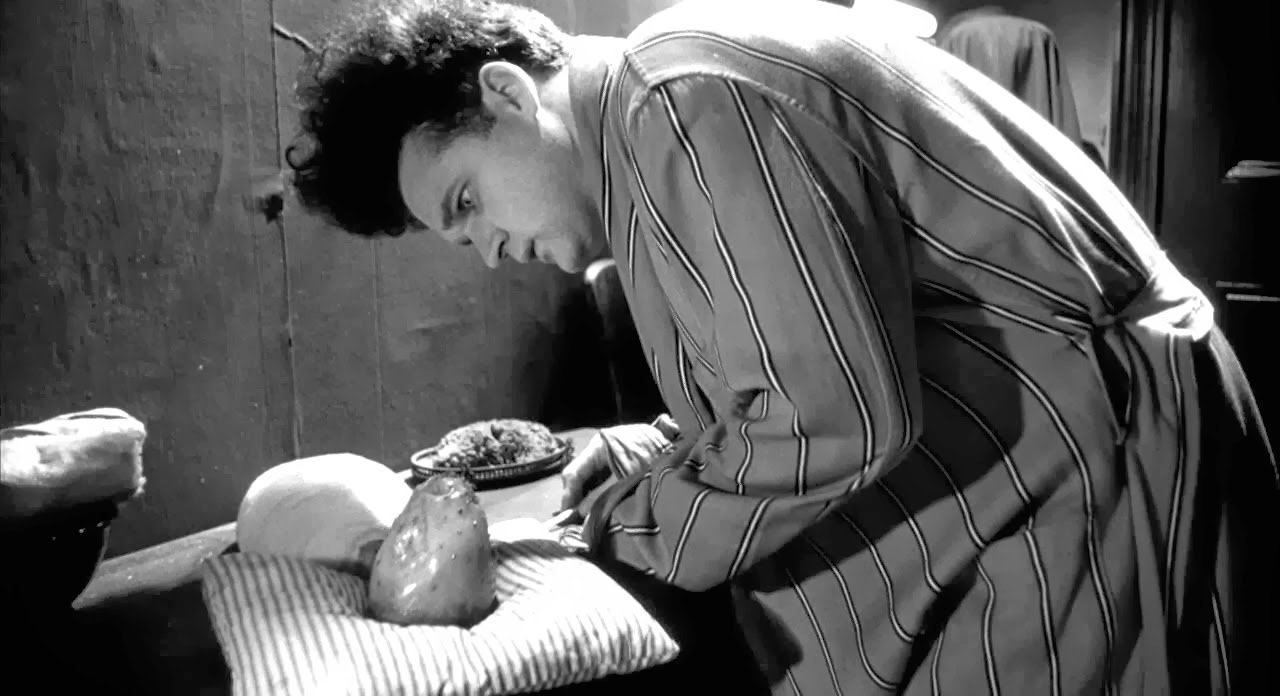David Lynch's "A THINKING ROOM" installation
via Dezeen ::
via Dezeen ::

Lynch had a clear vision for the space from the beginning, taking an interest in the materials and colours used and even creating a small decorative sculpture that sits at the top of the picture frames that hang on its walls.
"We sent him twelve samples for the walls, with more texture and less texture and many different blue shades," di Benedetto said. "He was happy like a child when he received all of the samples in LA."
On top of the large chair, seven metal rods connect it to the ceiling, where they branch out. Like the often ambiguous images in his films, the design was left unexplained by Lynch.
"The only thing that we know is that these are the connections between something like the soul and the absolute; a flow of energy from your soul," Monda said.
What a perfect tribute…
Created by Blue Rose Team, a small team made up of French developers Lucas Guibert and Jean Manzoni, Twin Peaks: Into The Night is a fan game that reimagines Lynch and Frost’s original series as a PS1-style survival horror game à la Silent Hill and Resident Evil, complete with tank controls and full-motion video exposition that repurpose footage from the show. Guibert and Manzoni released the first demo for the game on Tuesday, covering the events of Special Agent Cooper’s arrival at Twin Peaks and his first encounter with Laura Palmer in the Black Lodge.
(Written and directed by David Lynch; starring Jack Nance, Charlotte Stewart, Judith Anna Roberts, Laurel Near, Allen Joseph, Jeanne Bates, and Jack Fisk. Released 19 March 1977; watched 2023w19 via Criterion Channel )

That I'm as much of a David Lynch devotee as I am and have been for years (even when he climbs too far, as Quentin Tarantino said, up his own ass – though I did buy the 4k Criterion release of INLAND EMPIRE, which I'm nonetheless looking forward to seeing again), that I hadn't seen ERASERHEAD until now is (yet another) of my cinematic crimes in an otherwise solid record.
Hopefully subsequent viewings will let me see this marvel on its own two feet – it is, after all, Stanley Kubrick's favorite film – instead of taking it in as a reverse summation of Lynch's 40-year career but I can't deny my surprise and elation at how much of everthing – character, idea, trope, etc – Lynch has done/explored since can be traced to ERASERHEAD: The Lady in the Radiator = Lil in TWIN PEAKS: FIRE WALK WITH ME (and The Lady's plaster cheeks returning in the plaster mask of Mrs. Chalfont's grandson in FIRE); the "beautiful neighbor"= Isabella Rossellini in BLUE VELVET; Mary X's mom = Sarah Palmer; the tree in dirt and the baby (oh, that baby) became the Man From Another Place's latest incarnation in TWIN PEAKS: THE RETURN; the floor in Henry's apartment lobby (nevermind the curtains) is the floor in the Black Lodge; and nevermind that the whole film should have prepared everyone for the divine madness of TWIN PEAKS: THE RETURN's eighth episode (got a light?); and Jack Nance's Charlie Chaplin industrial channeling as Henry is revisited as his Charlie Chaplin channeling Pete Martell in the woods and environs of TWIN PEAKS (I miss Jack Nance so very, very much - should be mentioned in the same breath as Cazale, IMO; what a treasure)
Normally, if a creator was doing that, I'd say they're trying to refine and hone what they did in their earliest work: it's been said that we all do one work and everything is an attempt to make it better. Maybe that's true, but given that this is Lynch, it feels less like he's trying to improve with time and more like he's trying to return to this freedom, this time before success, when he was closer to being a painter than a filmmaker. He's called it his most spiritual film – and probably considers it his best. It was when he didn't know what he was doing and just doing - when he was most in his beginner's mind: if this is what beginner's mind brings, sign me up. Love it.
Perhaps the return to mowing the in-lawn was more beneficial than I thought, especially since I seem to have abandoned podcasts for audiobooks and, in this second grand mowing, managed to listen to all of David Lynch's - not David Lunch, as I usually type it – CATCHING THE BIG FISH. Fascinating to read/hear how many of my work habits – or, rather, the ones to which I'm trying to return – are from this book I picked up in a Salem, MA used bookstore more 15 years ago:
And then you go to work. The idea just needs to be enough to get you started, because, for me, whatever follows is a process of action and reaction. It's always a process of building and destroying. And then, out of this destruction, discovering a thing and building on it... Then it's a matter of sitting back and studying it and studying it; and suddenly, you find that you're leaping up out of your chair and going in and doing the next thing. That's action and reaction.
I've got the chair(s) and now I need to relearn how to allow myself that time and space – and to not fill the space I do have with pointless trivialities; as Don DeLillo reminds us, "A writer takes earnest measures to secure his solitude and then finds endless ways to squander it."
Though I've endlessly perused Lynch's ode to TM-infused creativity in the 15+years since I last read it, this was my first time re-reading it in its totality or, rather, having David Lynch read it to me while I drove in circles on a lawnmower (THE STRAIGHT STORY part of my days) which gave it a whole new life.
Apparently my fragmentary thinking – and my efforts to stay there – has/have been around for a long time:
It would be great if the entire film came all at once. But it comes, for me, in fragments. That first fragment is like the Rosetta Stone. It's the piece of the puzzle that indicates the rest. It's a hopeful puzzle piece...
You fall in love with the first idea, that tiny little piece. And once you've got it, the rest will come in time.
(These are my perpetual efforts to remember that final sentence.)
Recommended, wholly, just as it was 17 years ago – and especially worthwhile as an audio book, like Rubin's THE CREATIVE ACT: there's something about having both Lynch and Rubin speaking to you, whispering in your lone ear, lying in a field. Essential to the creative library.
Other note: I always have to type David Lynch twice, as I invariably type David Lunch the first time.
Recent Blu-additions:

Go Amazon: ‘Batman: Caped Crusader’ Lands Two-Season Order At Amazon After Being Axed At HBO Max | Deadline
I still hate that fucking movie: Unforgettable Oscars Moment: Lynch and Altman Lose to Ron Howard | The Daily Beast
Who Was Mr. Electrico, the Sideshow Magician Who Inspired Ray Bradbury—Then Vanished? | Smithsonian Magazine
Shirley Kurata: designer for the 'Everything Everywhere' multiverse | Raw Story
Excellent reminder of why I'm so vehement on owning your platforms and syndicating that brain-materiel elsewhere: How a social network falls apart | The Verge
Brilliant, brilliant show. Great interview on Charlie's looks and backstories behind them: “She goes chic very fast": "Poker Face" costume designer on creating Natasha Lyonne's iconic outfits | Salon.com
In a manner not dissimilar similar to how it took me eight years of mowing two two-acre lawns every week (I'm since retired) to start listening to podcasts, I've only just – after 11 years of running nearly every day – started listening to audiobooks (also a recent first) during the day's run. While my latent drummer muscle memory makes music-while-running a likely non-starter (as I will either run in tempo with the music or attempt to fit the music in my head to my tempo ) audiobooks present none of those difficulties (though they have their own, chief among them being a difficulty in processing everything that's coming at me, like listening to someone who won't shut up).
General practice: if I like what I'm hearing – as I do now, with Rick Rubin reading his own THE CREATIVE ACT (reminds me of David Lynch's CATCHING THE BIG FISH) – I buy the physical book both for easy revisitation and as a repository of noted memory. Along with Rubin, the other one that got that treatment was James Clear's ATOMIC HABITS (excellent, by the way. Might re-listen at some point). What both have in common was that the author themselves read the book; in Rubin's case particularly, it felt like / feels like I'm working with him; I get why artists want to. Can't imagine standard audiobook guy voice having the same impact – though standard audiobook guy reading certain lines is amusing in and of itself.
Sticking with non-fiction of the manual/idea variety for now (though I might add poetry), things that I have a harder time making myself make the time to sit and read each day. Philosophy, too.
“Just get me into that beautiful darkness with the soft wind…” RIP, Maestro.